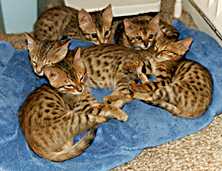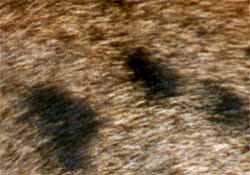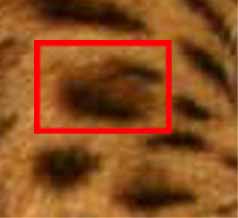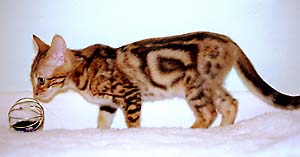
|
| |

|
|
Choosing a Bengal kitten | |||

The first litter of kittens from Tessa See photos of other kittens we have bred on our Gallery page (more photos added 8th June 2004) or Search : (Click on any photo here to display it much bigger - except the coat pattern examples ) |
Temperament
Choose a kitten which is not too timid around you (after a few minutes), even though they will settle down with you still better later. Many Bengal cats, especially kittens, do not like being picked up and may jump down when you give them a chance to do so - this is normal. However, they may well come to you of their own accord soon afterwards! Remember kittens are much more restless than adult cats. Health Don't buy a kitten with a runny nose or eyes or showing any signs of sickness or diarrhoea when you see it - go back later once the kitten is well. Make sure your kitten runs and walks easily. If your kitten has a sharp horizontal ridge along its ribs, this may be a condition called If your kitten is taking no interest at all in its surroundings, be cautious - kittens are usually either asleep, playing, curious, running around or suckling from their mother. Take your kitten to your Vet for a check-up very soon after you collect it. Good quality Bengal Kittens Your kitten must have a spotted belly (except Blue-eyed Snow Bengal kittens, see below) - if not, it is unlikely to be a true Bengal cat. Normal "black and gold" kittens : choose a kitten with a pale fawn to orange background coat colour and dark brown to jet black spots. | ||
|
Grey coats with striping along each hair - "ticked" coats - are a
serious fault. Expect to pay less for a ticked cat. This is an example of a
ticked coat (shown right, greatly enlarged). Notice the
mottled appearance of this coat - it is not just a plain grey coat
which may develop colour later.
Other background coat colours
can be found - "Snow Bengals" or "snows"
have a very pale background coat tending towards white.
(Please don't contact us for Snow Bengal kittens. We are not trying to breed snows.)
Judging a kitten's coat To see if your kitten has glitter, look at them in bright sunlight or the light from a single bulb - in other words, a point source of light. The fronts of paws and the fur around their eyes are often the clearest places to see glitter. The major problem in judging a Bengal kitten is that, from 3 weeks to around 6 months, the kittens develop what are called "guard hairs". These longer hairs seriously obscure the outline of your kittens spots. One idea which may help to see your kittens underlying spot pattern more clearly is to look at the kittens flanks almost from the back end of the kitten. This seems to make it easier to see the pattern through the guard hairs. The colour of a Bengal cats background coat will change until the cat is around one year old. Mostly, it will become stronger but sometimes it will weaken a little in colour. A Bengal cats coat should be short, beautifully soft and sleek; long hair as in a Persian is a very serious fault. |
 |
 |
Show quality Bengal Kittens - what to watch for
Spots should not be too small and the contrast between background coat and spots should be strong. Rosetting (dark spots surrounding a middle-coloured centre) is very prized. An enlarged example of rosetting is shown left inside the square. Vertical "rib stripes" are a disadvantage (though few cats are entirely free of them); if the stripes are broken into several pieces, this is much less of a fault than stripes running full height from shoulder almost down to the belly. Horizontal stripes are also a fault - but they are seen along the spine in almost all Bengal cats, as are horizontal stripes on the legs. Isolated white dots on the coat (known as "lockets") are a significant fault except small white spots just behind the ears, known as ocelli, which are very prized since they are a feature of Asian Leopard Cats! |
| Apart from spotted Bengal cats (such as Titan,
Tessa or Jasmine their daughter), the other main coat pattern
seen is "Marble", such as our kitten Shannon
(seen right, bred from Titan and Inca) who was sold in January 1999. These Bengal cats have much larger areas of
dark colour and can show a swirling pattern, sometimes looking a bit like a
section through a Swiss roll. Good quality, strongly-marked Marble Bengal cats can be extremely
attractive. |

Shannon at 13 weeks old |
|
These are our own thoughts and not necessarily shared by other Bengal breeders.
If you want to know more about something on this page, send us email at
hughandshirley@norcastle.co.uk.
For much more information, we strongly recommend a book by one of the founders of the Bengal breed : "Guide to Owning a Bengal Cat" by Jean S. Mill, ISBN Number See if we have kittens for sale on our for sale page. To find other Bengal cat breeders or helpful books about Bengal cats, try our Links page. For technical details on these Web pages, read our Technical page. Go to our Home page for the basics about Bengal Cats, or read our Who are we page to find out more about us, Norcastle kittens, the four quality levels, prices and what Active and Non-Active kittens are (with Bengal kittens, non-active could never mean boring!). See photos of kittens we have bred on our Gallery page. |
|
| |